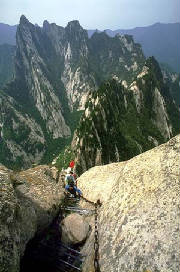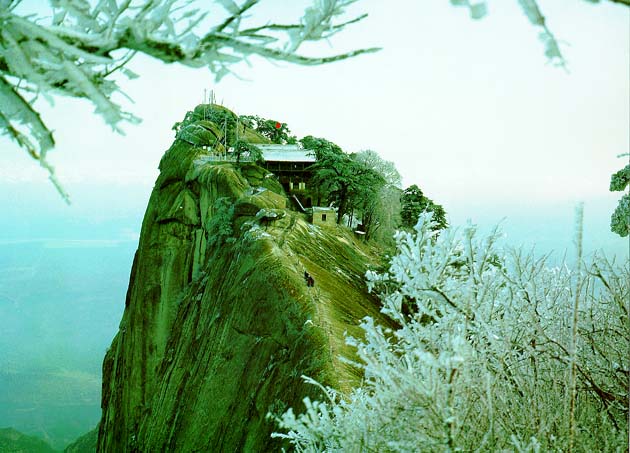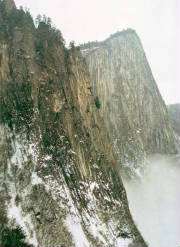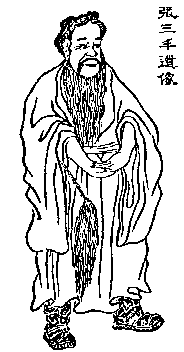Plexus: History vs. Myth (original) (raw)
History vs. Myth
Chinese martial history is often a story of famous people in famous places with amazing amounts of knowledge and ability. These stories are often ..complete, ...believeable, and ...cohesive. However, mostly, none of them are true. The history ...has been filled in where absent, ...the hero made greater than normal, and ...the events and places connected by leaps and shifts in time. Sometimes this is done in innocence, sometimes by cunning, and sometimes by students or family or a collective village creating it to give honor and/ or to continue their story telling. When the story starts with a mountain place [so high none could life there] with a great man who had the genius and time to write innumerable great books [of which none are now available] and a humble villiage or humble traveler was the lucky inheritent...mythical-legend meets commoners' wishful-wanting. Most 'pratitioners' claim that they are content..not to know ..as they just want to practice the exercise without ever knowing 'what' it is they are doing.
Also, following some of the principles of information theory, it is more easy to continue...go along with the forward momentum, of the story, than it is attempt to traverse backwards through its' linkages.
History is like a chain letter, it has a beginning which may be untraceable fully back, but in its' progress-telling, it is addended with (1) Concepts: Taoist ~ Buddhist, Alchemist ~Cosmology~Numerology (2) Study-Centers: Mt. WuTang--Hebei ~ Mt. Hua--Shensi ~ ShaoLin-Henan. (3) Time: Dynastys, and (4) People; ..each is resulting in the corruption and a bifurcation of facts...much like a chain-letter; a man with a big, blue, fish, becomes, a big man with a fish blue, and a big blue fish-man. Each junction of change influences both the direction and the timing [clocking] of what follows.
Words change their meaning, appearance, and usage overtime: the word Qi (chi) had a closer meaning to 'flow~spirit' than it does now as 'energy'; the idea of Qi before was as unclear as it is now. The word dao (tao) now is used as 'the way', before, its' meaning was man's making of order.. a treking path across a wet, flooded field. The authorities of Red China mandating pinyin chinese has the result of erasing etymology and history; it also effects a need to learn more Beijing idioms; it is quite naive to accept pinyin's oddities of transliteration over the already established traditional chinese.
| Climbing the Chain-ladder |
|---|
[ ](/imagelib/sitebuilder/misc/show%5Fimage.html?linkedwidth=actual&linkpath=https://waterspirit6x8.tripod.com/sitebuildercontent/sitebuilderpictures/huashanladderclimb.jpg&target=tlx%5Fnew&title=Climbing the Chain-ladder) ](/imagelib/sitebuilder/misc/show%5Fimage.html?linkedwidth=actual&linkpath=https://waterspirit6x8.tripod.com/sitebuildercontent/sitebuilderpictures/huashanladderclimb.jpg&target=tlx%5Fnew&title=Climbing the Chain-ladder) |
| A trek to the top of Mt.Hua |
The subject-divisions chosen for elaboration are as follows:
(1) Concepts: Taoist, Buddhist, Alchemists, Cosomolgy, Numerology. Concept-Application: health-exercise ~ martial-exercise Most martial history authorities accept that the concept of water as a widely used simple symbol for the more complex concept of 'spirit'; both the name 'water' and 'spirit' were applied to various exercises and concepts. Early exercises were called 'river', 'long', or 'soft' and flowing. Cosmological concepts existed as 'central', 'foundation', by importance: greater, lesser, and temporal: before, after, etc. Such names as tai-chi and ba-gua existed early, mostly theoretical guides or were part of prognostication, but their application to exercise principles or form patterns did not occur until much, much later eg. 1200-1400 and by then the intrepretations of each had changed.
(2) Time-Event:
Pre-Sung; First-Sung Dynasty: circa 900AD-990AD; martial arts existed from many earlier dynasties and archaic pre-histories. [Special note needs to be given to the Tong Bei 'through the back' spinal reflex principle that dates back to the Tang Dynasty.]
The locations of interest involve both province, place, and 'centers' within them, these clusters are connected for various ideological reasons or by geography. It should also be noted thatWuTang Shan, -JiuHua Shan-, Huang Shan create both cluster of mountain barriers north to south and between them exists a collective source of some of the most esoteric philosophers; ...big minds perhaps benefit from big mountains.
- Shao Lin [Little Forest Temple] in Henan
- Mt. WuTang [Tai-He=supreme harmony; xuan yue] in Hebei
- Mt. Hua [Hua-Yo=west pinnacle] in Shensi
- Mt. Jiu Hua [nine flower mountain] in Anhui
- Mt. Huang ['yellow'] in Anhui
| Mt.Hua Pinnacle |
|---|
 |
| High, perilous prison |

Mount Hua 華山 is the legendary, unproven locale-source of teachings/ documents / myths regarding Taoist recluse-scholar-advisor Chen Tuan of 'Bo' and an exercise or group of health/ martial exercises attributed to him. Currently the martial exercise has been called 'water' boxing and at one time 'spirit' boxing. The jumps and transference of 'water-spirit' exercise from Mt.Hua or Chen Tuan to the now named LiuHe BaFa exercise is quite dubious and unaccepted by martial-arts historians. The name 'water' boxing seems to be both an ad hoc naming and a pervasive, but incorrect, easy marketing name.
Connections to Mount Hua [ HwaYo, Xi Yo, Xi Hua ] :
(+)The name Hua Yo 華嶽 [hwa yue] or Hua Pinnacle is symbolic as a symbolic 'apex' of knowledge; it remains today as a symbol for high hopes or ability_. Hua-shan_-style health or martial exercise itself has a legendary history and is usually referred to as unique and to the highest standard. The name 'tai chi' is also used as the high apex of 'supreme' and of the 'ultimate'...in a physical and cosmological sense.
(+) The name Mt.HuaYo XiYi sect華嶽希夷門 appears as both a taoist sect appearing long after Chen Tuan..Msr XiYi's death whose Mt Hua chapter exploited his name and two of Msr. Wu Yi Hui's teachers claimed that their teachings were similarly named. [Wu's other teacher called it 心意六合八法拳, the central ideas of LiuHe- and BaFa- boxing.
(+) The name Mt.Hua Yo 華嶽山 has been associated with a poem title about LHPF=as the six-harmony combinations, eight methods; the origininator of the poem is unknown, but is either credited to Chen Tuan of Bo at Mt.Hua or to Li Dong-Feng at Mt. Qi-Yun in Anhui [some take Msr Li as the exercise source.]
(+) Hua Yo is also a distinct mixed martial style: marketed in Boston by Hong Kong teacher John Chung Li [Li Chung] who studied the variants of LHPF and under instruction from friend and Yi Quan teacher Han Xing-Yuan, they redesigned the LHPF to be more Yi-Quan inclusive; Li Chung's taichi teacher-friend: T.T. Liang (a teacher of the Cheng Man-Ching-37-form style of tai-chi in Boston ) suggested to Mr. Li to market this unknown exercise under the already known 'tai-chi' name as HwaYu Tai Chi-. There is also an ancedotal story that conflicts regarding changes between HK teacher Chen YY and teacher Liang Zhi-peng also resulted in a HwaYo Tai Chi-naming of the style.
Also of interest, recent emergence of 'Shanghai'-style LiuHeBaFa~water-style shows strong influcence of yiquan forms not evident in the Nanking style of Wu Yi-Hui. Li Chung was also part of a group of private students in Hong Kong who learned an exercise system called HunYuan, this is remarkably similar to LHBF, but is based on small spiraling motions; this later was incorporated in Li Chung's teachings. Overall Msr. Li's teachings purposely distance themselves from usual, traditional LHBF.
(+) HuaYue-Tai Chi is the name and spelling of the current version of Li Chung's LHPF+YiQuan as being developed in Denmark; [either spelling of HwaYu, HuaYo, or HuaYue are used in China, thus the 'denmark' spelling of HuaYue is quite acceptable] Hua Yue Tai Chi Institut info@huayuetaichi.dk
Hua-Shan~Hua-Yo: Nearly every reference to this mountain as a source of exercise refers to it as either _HuaYo_~Hua peak or as Xi Yo~west flower mountain. A note: chinese and their use of language often is aware and concerned about the use of homonyms, words that sound similar, thus Hua-Shen~flower-Mt. + spirit refers to the goddess of flowers: bai hua shen; also _Hua-Xin_~flower + heart refers to the 'heart of the flower', slang, vagina. A more common and direct interpretation is that the cluster of peaks known as Huashan, collectively is five pinnacles; incorporating chinese symbolics, the lotus flower, lien hua (lien being a homonym for 'link') it becomes a comparison, the cluster of peaks reminds one of the clustering of a lotus flower. With this in mind, the usual translation of Huashan as 'flower' mountain or as 'resplendent' mountain is somewhat incorrect.
It is said that the Chinese 'see' with their ears, meaning, there is pictures in the word, saying that you practice famous Hua-xin-yi could be interpreted in an amusing alernate way.
References : Hua Shan :
http://medicine.webhostme.com/huashan.htm
http://www.damo-qigong.net/huashan.htm
http://www.letsgo.com/CHI/06-CentralChina-112
http://www.letsgo.com/CHI/06-CentralChina-85?PHPSESSID=8f26f117a146878271351cd9dd06f9a2
http://www.letsgo.com/CHI/06-CentralChina-3
| Tomb of Hua T'uo |
|---|
| at Hua Shan |
Doctor ...on the Mountain :
It is interesting that the famous doctor/ surgeon Hua T'uo, at a previous time, is said to have lived, studied, taught, and is now entombed at Mt. Hua. Doctor Hua's entry into this history string is of interest: as the said developer of a 'five-animal' health-dance [ said of influence to Chen Tuan; and also to xing-yi and many others..none of this being verifiable.].
[ Even now, the Chinese government has stated, that even without University Certifications, if they had someone of the abilities of a Hua T'uo, they would use him as a rural doctor [...then Chen Tuan as a philosopher, having no formal credentials also, would he be used as a teacher??] This again is myth making. It can be shown that many texts are either attributed to Chen Tuan or include him as 'co-authority'. As much as Red China has tried to erase a superstitious history it now is used to glorify and to attract tourists.
Tai Tzu Chang Chuan 太祖長拳**'Long' Boxing**
Reputedly, in mythical stories, Chen Tuan met Emperor Chao, Kuang Yin, in 960 AD, The two stories are : Chen Tuan taught King Chao an exercise to maintain his health_: tai chi-chih_, the ruler-method of tai Chii-like principles to practice.
The tai chii-ruler exercise then came under the Chao family lineage for its transmission; it has been taught under the same name by many in America, but has been either incorrectly interpreted/ taught or reworked into a 'kinder-gentler' tai chi in comparison with the Yang-family version of taiji-principles which have a long history of development from principles introduced into and mixed with Chen-family exercises.
King Chao [Tai Zu] is also credited with developing Tai Tzu Chang Chuan .
"The original style was a 32 move Long Fist form, but eventually grew to have as many as 100. Tai Tzu Chang Chuan is also said to be one of the early influences on the Chen family style of boxing, and an influence on Northern Mantis and Ngo Cho Keun as well. It is a powerful style with flowing movements, it's popularty rivales that of the Shaolin in the Ming dynasty and was standard military training during that time. As a student of Chen Tuan, Emperor Chao also created an internal version of the system based on Chen Tuan's teachings. During the Southern Sung dynasty, his descendants created another exercise with the same name, shorter and with more upper body emphasis than the original. As they are complementary, both are taught side by side today."
Excerpted from Royal Dragon, Downers Grove, Chicago
http://www.royaldragonusa.nethttps://waterspirit6x8.tripod.com/id9.html
Quote re: tai zu mantis
MEETINGS : [ the usually said suspects ] ..often claimed for Chen Tuan
>Emperor Mingzong- First emperor to offer Chen Tuan a position.
>Zhao Kuangyin (Emperor Taizu)- Elder brother, founder of the Song Dynasty; asks Chen Tuan to join his court
>Zhao Kuangyi (Emperor Taizong)-Younger brother, second emperor of the Song Dynasty; asks Chen Tuan to join his court; after 20 years, asks Chen Tuan to advise him about choosing the correct son to take his place as emperor
>Yuankan, Prince of Xiang- Emeperor Taizong's third son who is crowned Emperor upon Chen Tuan's approval
- HuoLung-'fire' drgaon; Mt.Hua~WuTang ~Chang SanFeng~Wu Tang
- Lee, TungFung; => Sung, YuenTung, his 'student'.
Sage meets King: Reputedly, Chen Po met Emperor Chao, Kuang Yin, in 960 AD. There are two stories: (1.) Chen Tuan taught King Chao an exercise to maintain his health_: tai chi-chih_, the ruler-method of taiji-principle practice. The taiji-ruler exercise then came under then Chao family lineage for its transmission; it has been taught under the same name by many in America, but has been either incorrectly interpreted/taught or reworked into a 'kinder-gentler' taiji in comparison with the Yang-family version of taiji-principles which have a long history of development from principles introduced into and mixed with Chen-family exercises. (2) King Chao is also credited with developing Tai Tzu Chang Chuan , Tai Tzu's Long Boxing.
| Chang 'san-feng' |
|---|
 |
| 'three-hills' of myth |
Sage meets Sage:
The story regarding Chang SanFeng and Wu Tang is untrue; the existence of Chang 'three-hills' is erroneous and appears to be a mythic-figure only; tai-ch'i principles [ not called as such historically] can be easily shown to have existed in pre-Tang Dynasties ane were inputs to Chen Village boxing. [ It was only called 'tai-chi' boxing beginning with the Yang-Family, late 1800's, as observed by the Manchu Court.]
A creditable linkage would be that a protege of Chen Bo went to Wu Tang; the reverse story that Chen Bo first went to Wu Tang before going to Mt.Hua is plausible, but suggests that Wu Tang 'taught' Chen Bo his exercises. Ultimately, the relation between Mt. Hua and Wu Tang becomes the more important story, not between Chen Bo and a Chang SanFeng. Shao lin temple 少林 in Henan is known to be the oldest 'institution' of martial exercise offering both rou quan 'soft' boxing 柔拳 and a xinyi-ba boxing 心意把 a proto-type 'xinyi-' that was also a source of yi quan to Wang Xiang-zhai.
The story that Chang 'realized' the principles upon viewing a fight between a bird and and snake is not original; the same visualization is claimed for the origins of Wing Chun boxing. There is added the already known possibility that there is more than one Chang San-feng and that each lived in different time periods; the suggestion that Chang lived throughout all time periods represents the gullibility of the believers.
Mythical Life of Chang San Feng :
References :
P. Garofalo http://www.egreenway.com/taichichuan/chang1.htm
John Hancock http://www.geocities.com/Tokyo/Pagoda/9536/chang.html
Ottawa Martial http://www.geocities.com/ottawakungfu/200TaiChi002.htm
http://www.chebucto.ns.ca/Philosophy/Taichi/history.html
http://www.chinavoc.com/kungfu/cbox_taiji.htm